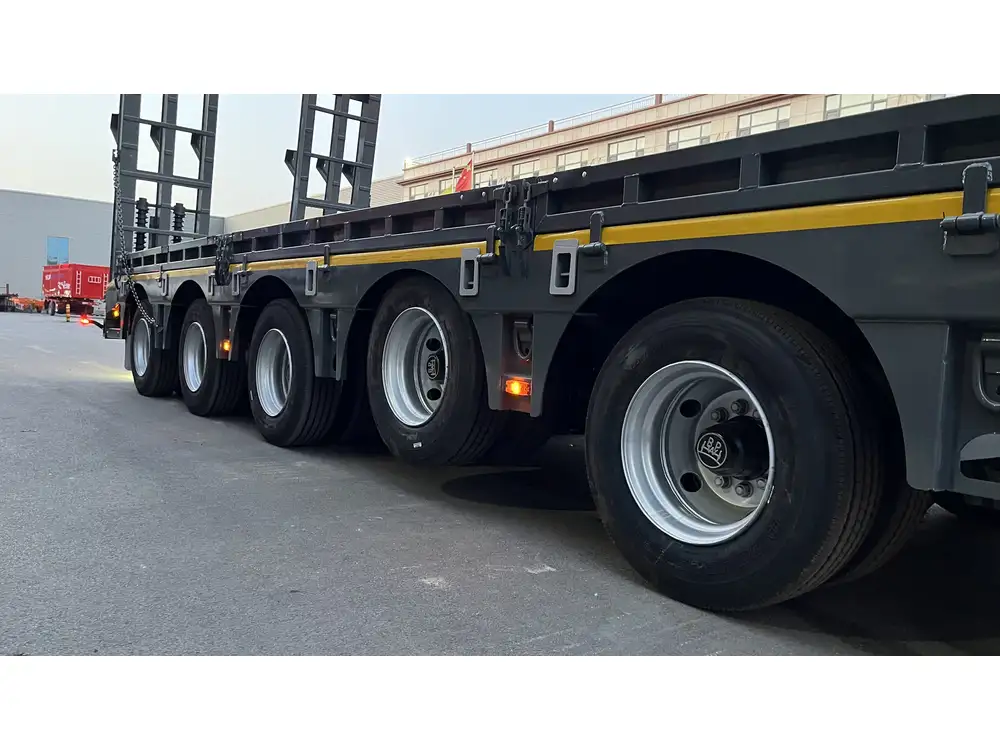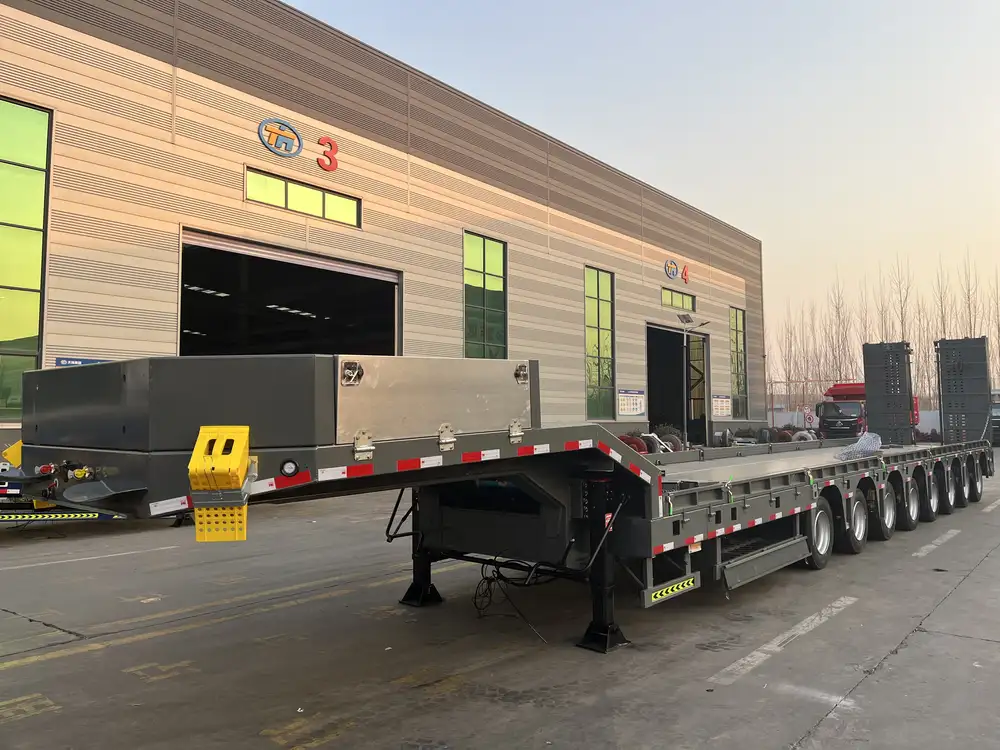When dealing with the transportation of heavy goods, understanding the loading capacities of your equipment is paramount. Specifically, for operators working with flatbed trailers, the question arises: How heavy can you load a flatbed 48 trailer? This article will detail the weight limits of flatbed trailers, the factors influencing these limits, important regulations, and best practices to optimize loading while ensuring safety and compliance.
1. Flatbed Trailer Overview
1.1 Types of Flatbed Trailers
Flatbed trailers come in various configurations, suited to different types of cargo and transport needs. Here are some common types:
| Trailer Type | Description |
|---|---|
| Standard Flatbed Trailer | Typically measures 48 to 53 feet in length, with a flat platform for easy loading. |
| Step Deck Trailer | Features a lower deck for tall cargo, allowing taller loads without exceeding height limits. |
| Double Drop Trailer | Designed for carrying exceptionally tall loads; offers maximum height clearance. |
| Extendable Flatbed Trailer | Can be lengthened or shortened based on the cargo, accommodating longer materials. |

1.2 General Specifications
Flatbed trailers generally have a gross vehicle weight rating (GVWR) between 48,000 and 65,000 pounds. The limit you can load ultimately depends on several factors that include, but are not limited to, the trailer type, its configuration, and the weight of the tractor itself.
2. Legal Weight Specifications
2.1 Federal and State Regulations
In the United States, the Federal Highway Administration (FHWA) regulates maximum weight limits for commercial vehicles. The standard weight limits are as follows:
- Single Axle Limit: 20,000 pounds
- Tandem Axle Limit: 34,000 pounds
- Gross Vehicle Weight Limit (GVW): 80,000 pounds
States may have their own specific variances, thus it’s vital to consult state regulations as they can differ significantly. For instance, certain states allow for higher weight limits under special permits.

2.2 Weight Distribution
Weight distribution across axles is another critical consideration. Improperly distributed loads may lead to legal repercussions and increased risks of accidents. Riders must adhere to these distribution guidelines:
- For Two Axles: Load must be evenly distributed between the axles.
- For Three Axles: The weight on each axle should not exceed its designated limits while abiding by the total GVW limit.
3. Calculating Payload Capacity
Understanding how to calculate payload capacity is essential for ensuring compliance and safety.
3.1 Step-by-Step Calculation
Determine the Trailer’s Gross Vehicle Weight Rating (GVWR):
- This value is typically found on the manufacturer’s plate affixed to the trailer.
Subtract the Weight of the Empty Trailer:
- Find the trailer’s tare weight (empty weight) to accurately assess how much weight you can legally load.
Calculate Payload Capacity:
- [ \text{Payload Capacity} = \text{GVWR} – \text{Tare Weight} ]
For example, if a 48-foot flatbed trailer has a GVWR of 48,000 pounds and a tare weight of 10,000 pounds: [ \text{Payload Capacity} = 48,000 – 10,000 = 38,000 \text{ pounds} ]

3.2 Additional Factors
Keep in mind that payload capacity can be influenced by:
- Trailer Configuration: Specific designs, such as lowboy or step-deck trailers, may have different capacities.
- Axle Count: More axles usually mean higher weight limits due to increased load distribution capabilities.
- Condition of the Trailer: Wear and tear can affect the structural integrity of the trailer, potentially decreasing its weight capacity.
4. Best Practices for Loading Flatbed Trailers
4.1 Proper Techniques
- Use of Securing Equipment: Utilize straps, chains, and binders to secure loads effectively. Properly secured cargo prevents movement during transport and helps maintain stability.
- Level Loading: Ensure that the load is well-balanced and evenly distributed across the trailer to avoid tipping, swaying, or excessive strain on one side.

4.2 Load Distribution Tables
To assist in planning, here’s a simplified table that demonstrates maximum load limits based on axle counts and distribution:
| Number of Axles | Maximum Load (lbs) | Recommended Load Distribution |
|---|---|---|
| 2 Axles | 34,000 | 17,000 lbs per axle |
| 3 Axles | 42,000 | Up to 20,000 lbs on the front axle |
| 4 Axles | 48,000 | Evenly distributed |
4.3 Monitoring Weight During Loading
Utilize weight scales wherever available. Many commercial freight terminals provide access to scale facilities. Ensuring your load doesn’t exceed the permissible weight is not just compliance; it’s integral to road safety.
5. Consequences of Overloading

5.1 Legal Repercussions
Overloading a flatbed trailer can lead to significant legal troubles, including fines, penalties, or more severe consequences if an accident occurs because of improper loading.
5.2 Safety Risks
Overloading can dramatically impact braking distances, vehicle handling, and overall safety. It poses a risk not only to the driver but also to other road users.
5.3 Equipment Damage
Excess weight can cause extensive damage to the trailer and tractor. Components such as tires, brakes, and suspension systems are particularly susceptible to wear and might lead to expensive repairs or replacements.

6. Examples of Heavy Loads for Flatbed Trailers
Understanding real-life scenarios can aid operators in practical applications. Here is a list of common heavy loads transported using flatbed trailers:
| Type of Load | Estimated Average Weight (lbs) |
|---|---|
| Steel Beams | 5,000 – 10,000 |
| Heavy Equipment (e.g. excavators) | 20,000 – 40,000 |
| Lumber (stacks) | 10,000 – 30,000 |
| Industrial Machinery | 15,000 – 30,000 |
| Shipping Containers | 28,000 – 30,000 |
7. Regulatory and Compliance Tips
- Keep Documentation: Maintain proper documentation for weight checks and ensure all relevant permits are obtained, particularly for oversized loads.
- Regular Vehicle Inspections: Conduct routine checks on trailers to assess their condition and ensure all components are within rated capacity.
- Training and Awareness: Train drivers on loading protocols and compliance regulations. Encourage awareness of weight limits and distribution principles.
8. Conclusion
In conclusion, the loading capacity of flatbed 48 trailers varies depending on several factors, predominantly the GVWR, axle configuration, and state regulations. Careful calculations and adherence to weight distribution practices are vital to maintaining safety and compliance in the transportation industry. By implementing meticulous loading strategies and following best practices, operators can ensure they remain within legal limits while effectively transporting their goods. Understanding these intricacies not only protects your business but also promotes safety on the roads, fostering a more responsible transport ecosystem.



